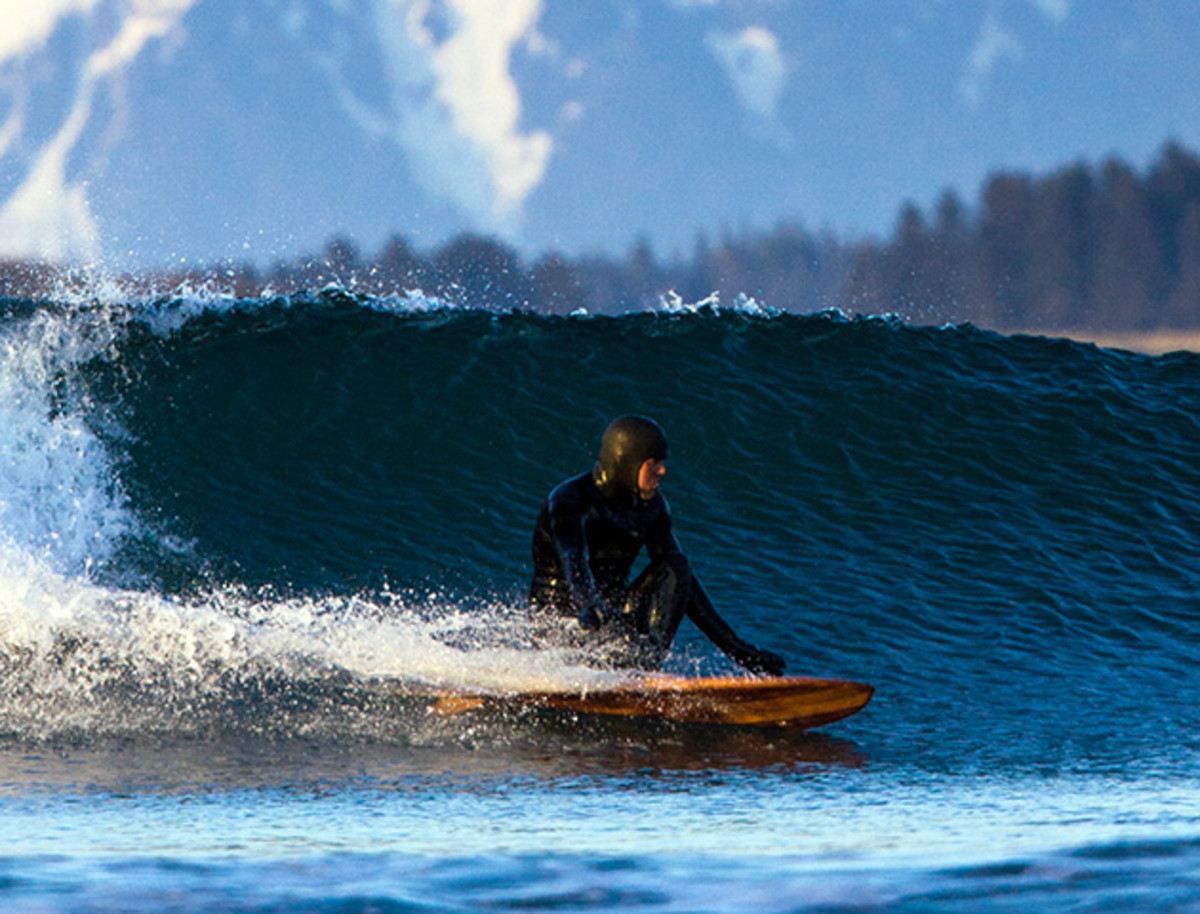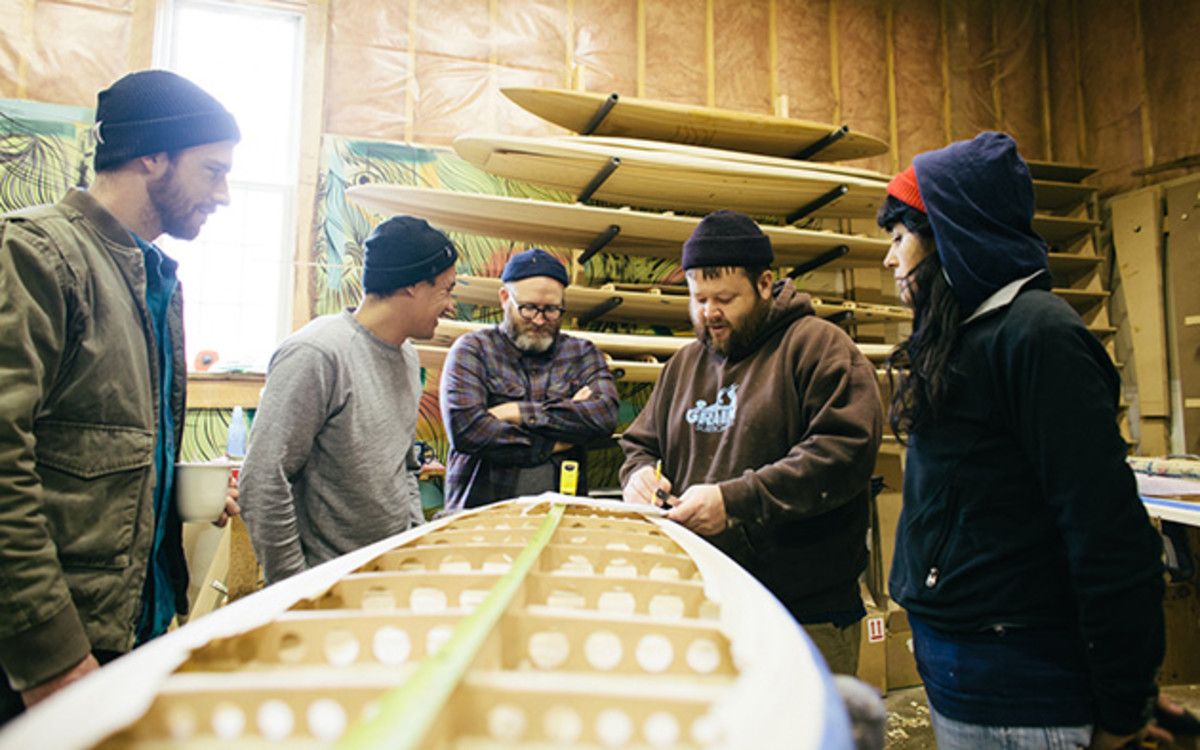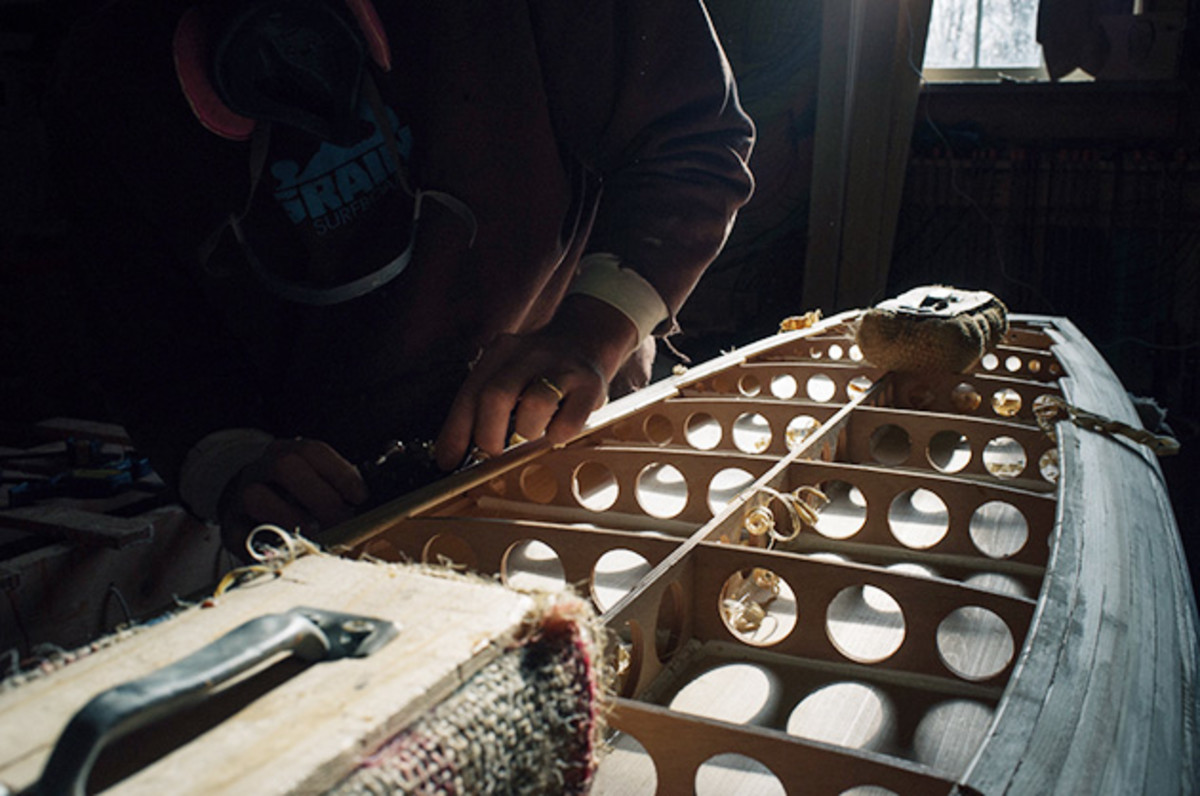Grain Surfboards produces works of wave art, each handcrafted in wood

To find the headquarters of Grain Surfboards, turn away from the beach. Drive 10 minutes past the steepled church in York, Maine, past the clam shacks, past the farmstand that advertises Fresh Corn, Butter, Sugar, and then you might see a small wooden sign that reads Grain Surfboards .5 miles on the left.
If you’re not looking for it, you’ll probably miss it.
Down winding Brixham Road, you’ll reach a white-shingled barn. Inside, there’s a dining table. And a Lazyboy chair. Copies of The Surfer’s Journal and Nautical Quarterly fill a small bookcase next to the kitchen. A dog with a brown coat and sharp ears naps on a couch, then stirs when a visitor arrives.
“Don’t worry,” says Mike LaVecchia, the founder and co-owner of Grain. “She barks a lot, but she’s not angry.”
The secluded destination reflects the core philosophy of LaVecchia and co-owner Brad Anderson: Challenge convention. Whereas most surfboards today are shaped from polyurethane (PU) or expanded polystyrene (EPS) foam, the handcrafted boards by Grain are built with local, sustainably harvested Northern White Cedar wood. LaVecchia and Anderson could select wood from Canada for half the price, but they won’t sacrifice quality for cost.
Hey, bro, at the Pipeline, Quiksilver surfer Reef McIntosh runs the show
says. “We want to buy Maine wood and support the local mills.”
A stout man with a full beard and gentle eyes, LaVecchia, 49, picks up a spokeshave and handles it like a sculptor wields a chisel. He started working with wood when he made his own snowboards while growing up in northern New Jersey. That tinkering led to a job at Burton. After 12 years in the snowboard industry, LaVecchia shifted his focus. He managed the construction of an 88-foot wooden schooner for the Lake Champlain Maritime Museum in Vergennes, Vt. After moving to York so he would have a shorter commute to surf, he embarked on another mission in 2005.
Build a better surfboard.
LaVecchia drew inspiration from the first hollow wooden boards made by Tom Blake in the late 1920s and applied his boating knowledge to build his first surfboard, named Eve, in his basement. Made from Western Red Cedar, Eve featured caulked seams, bronze fasteners, and marine varnish. It took LaVecchia three months to finish. He kept experimenting in relative anonymity and built about seven boards when N’East Magazine published an article about the local business. Anderson read it. He visited LaVecchia. They talked about design for hours. They became business partners and sold 330 “HomeGrown” surfboard kits, in their first year. In 2007, they moved the company to their current location, which doubles as a working farm.
“This is where we live, and Grain came out of that,” Anderson says.

.
“It’s not apparent at first, because we have this nicely scented cedar, hand-crafted product,” Anderson says, “but we also use a very detailed technology to design the boards.”
Still, the process demands far more labor than shaping a board from foam, which entails only a couple of hours. Each Grain board takes 50 to 60 hours. And unlike the division of labor seen at most surfboard manufacturers, at Grain one craftsman builds each board from start to finish.
You can too. Custom board orders, which typically range from $1,800 to $2,200, account for 50% of Grain’s business. The other half derives from the company’s kits ($600-$870) and four- or seven-day workshops ($1,750 to $2,000), in which you construct a board of choice beside Grain’s expert builders.
Skimming or surfing? Brad Domke's wave-riding seemingly defies physics
.
Grain has had “students” from Brazil, Singapore, Australia, and Japan. Last September a South Korean couple visited and built a 6'2" Channel Islands “Biscuit” model. Grain partnered with Channels Islands and legendary shaper, Al Merrick, in 2009 to copy the popular board in their construction.
Even with their global reach, LaVecchia, Anderson, and Grain’s handful of board builders and employees have retained their commitment to quality and sustainability. They glass all boards in organic epoxy resin. They have an “Offcuts Initiative,” whereby surplus wood is repurposed for skateboard decks or handplanes. Leftovers are then used as garden mulch or animal bedding for the #graincows.
One of Grain’s mottos is Waste no waste.
This particular afternoon in late October is the first of a four-day workshop. Workstations line the left side of the shop. Clamps are everywhere. Wood shavings cover the floor like blonde locks in a barbershop. Grateful Dead plays in the background. What’s missing is the whirring of power tools. They’re seldom used.
“If you get good at using hand tools, then they become very efficient,” LaVecchia says.

says. “If your foundation is not square, it’s not going to work”
One piece of a frame sits on a coffee table in the front room and others dangle from the ceiling like mobiles. Their intended purpose, though, is to improve the hollow board’s strength with minimal weight. It’s the materials of Grain boards and their unique construction that helps them far surpass polyurethane boards in longevity. Some of the 20 or so demo boards in the front room of the workshop are about seven years old. They look new.
“There is a misconception that wood is fragile,” Anderson says.

, and Keith Malloy, who have all built Grain boards.
“I definitely have a new appreciation for wooden boards,” Malloy says. In 2013, he built a 9'6" “Cutwater” classic noserider longboard during a workshop at the Patagonia store in Cardiff, Calif. “It felt really cool to build the board then be riding waves on the final product. There are so many small steps in order to make such a beautiful board, you feel part of it.”
When Malloy brings his board to the beach, he often gets several looks and questions. He says he feels pride when he discusses Grain, the board’s origins, and can say, “I made it.”
The SI Extra Newsletter Get the best of Sports Illustrated delivered right to your inbox
Subscribe
“We live in a such a consumer environment that we start to forget we have the capacity to make these incredible things,” Anderson says, sitting at a wooden picnic table outside the Grain barn. “Everyone usually enters [the workshops] with doubts but by the end they are amazed at what they created. You can’t buy an experience like that.” He pauses. He stares into the distance towards the edge of the property. The sun begins to set and makes the trees’ foliage the color of pumpkins shimmer.
“Wait, actually you can,” he says. “We offer it.”
